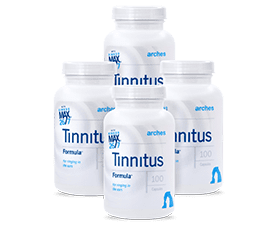By Barry Keate
Barry Keate, has lived with tinnitus over 40 years and has published 150+ research articles on numerous aspects of tinnitus. He is an expert on the condition and a well-known advocate for those with tinnitus.
GABA (gamma-aminobutyric acid) is a brain neurotransmitter that inhibits electrical activity and reduces tinnitus and other conditions, such as anxiety, depression and epileptic seizure. We have discussed in previous articles the central role that GABA plays in many neurodegenerative conditions, including tinnitus. A new study shows that yoga practice can substantially increase GABA levels and, by extension, reduce tinnitus.
 In 2002, Drs. Abraham Shulman, Arnold Strashun and Barbara Goldstein, from the Martha Entemann Tinnitus Research Center, published a paper describing the common central pathway through the brain through which all tinnitus symptoms must travel.1 This pathway, they determined, is the chemical receptor called gamma-aminobutyric acid-benzodiazepine-chloride receptor (GABA/BZ/Cl) in the medial temporal lobe system.
In 2002, Drs. Abraham Shulman, Arnold Strashun and Barbara Goldstein, from the Martha Entemann Tinnitus Research Center, published a paper describing the common central pathway through the brain through which all tinnitus symptoms must travel.1 This pathway, they determined, is the chemical receptor called gamma-aminobutyric acid-benzodiazepine-chloride receptor (GABA/BZ/Cl) in the medial temporal lobe system.
The researchers stated the function of the GABA receptor is to inhibit central nervous system synapse activity. Deficiency in the GABA receptor is directly related to the worsening of tinnitus, which is marked by increased emotional difficulty, anxiety, stress, depression and fear. Impairment of GABA function also leads to convulsions, which provides clinical support for the concept that tinnitus is an epileptic-like auditory phenomenon.
The authors of the paper went on to treat tinnitus patients with Neurontin (a common anti-seizure medication) and Klonopin (a benzodiazepine anti-anxiety medication). They reported significant reduction in tinnitus intensity and annoyance in most of their treated patients. Neurontin, however, caused significant side effects (including sleepiness, dizziness, nausea, and anxiety) and 30% of the patients dropped out of the study because they could not tolerate them. This treatment is discussed in greater detail in our article “Brain Receptors and Tinnitus.”
A recent study conducted at Harvard Medical School and Boston University School of Medicine showed that a 60-minute yoga session increased GABA levels 27% over that of the control group, who spent the time reading. The study was published in the Journal of Alternative and Complementary Medicine. 2
The researchers explain that GABA dysfunction is a factor in mood and anxiety disorders. Cerebrospinal fluid studies have demonstrated low GABA levels in depressed subjects compared to controls. Since yoga has shown promise in improving symptoms associated with depression, anxiety disorders and epilepsy, they hypothesized that the ability of yoga to decrease symptoms in these disorders is mediated through the GABA system and can be measured using magnetic resonance spectroscopy (MRS).
Yoga practitioners were instructed to spend a 60-minute time period that focused on the yoga postures, known as asana yoga. The study design focused on asana yoga because the postures are observable, as opposed to the internal state of meditation. The control group was instructed to read magazines or books for the same 60-minute time period.
The study demonstrated that a 60-minute asana yoga session in established yoga practitioners is directly associated with a 27% increase in GABA levels. The control group did not demonstrate an increase in GABA.
Dr. Chris Streeter, the lead researcher for the study, is a neurologist and a psychiatrist at Boston University. She is also a yoga practitioner. She stated in a newspaper interview “I’m quite sure this is the first study that’s shown there is measurable change in a major brain neurotransmitter with a behavioral intervention such as yoga. What’s really fabulous is this is hard science that is able to clearly document neurochemical changes in the brain.” 3
Dr. Streeter learned that the National Institutes of Health gave a high score to her research grant proposal for a larger yoga-GABA study and hopes to begin soon. “It will be a much bigger study,” she said. “We will use yoga-naïve people to gauge how regular practice can change GABA levels. It will also include more ability to gauge the positive effects of yoga over time.”
In a separate published study, researchers at the University of Rajasthan, India, found that yoga postures and breathing exercises can help reduce the frequency and intensity of migraine headaches.4 The study followed 72 migraine-troubled adults who were randomly assigned to take part in a yoga therapy program or a headache education group.
After five months of gentle yoga postures and breathing techniques, the yoga participants reported fewer attacks and much less intense pain.
In cases of acute anxiety and stress, doctors frequently prescribe medications such as Valium, Klonopin or Xanax to control symptoms. These medications can be effective but, unfortunately, they are addictive and the more you take of them the more you need to obtain the same effect. With this new research we now know that regular yoga practice can reduce these symptoms and tinnitus without medication.
- Shulman A, Strashun A, Goldstein B. GABA-Benzodiazepine-Chloride Receptor-Targeted Therapy for Tinnitus Control. Int Tinnitus J. 2002;8(1):30-6.
- Streeter C, Jensen E, et al. Yoga Asana Sessions Increase Brain GABA Levels: A Pilot Study. Journal of Alternative and Complementary Medicine. Volume 13, Number 4, 2007, pp. 419-426.
- Seattle Post-Intelligencer, June 17, 2007, Health & Fitness.
- John PJ, Sharma N, Sharma CN, Kankane A. Effectiveness of yoga therapy in the treatment of migraine without aura: a randomized controlled trial. Headache 2007 May;47(5):654-61.
Get Free Shipping!
Order now and get free shipping on either the Tinnitus Starter Kit or Combo Pack. Try the doctor recommended products with clinically proven ingredients for tinnitus. No coupon code required.

